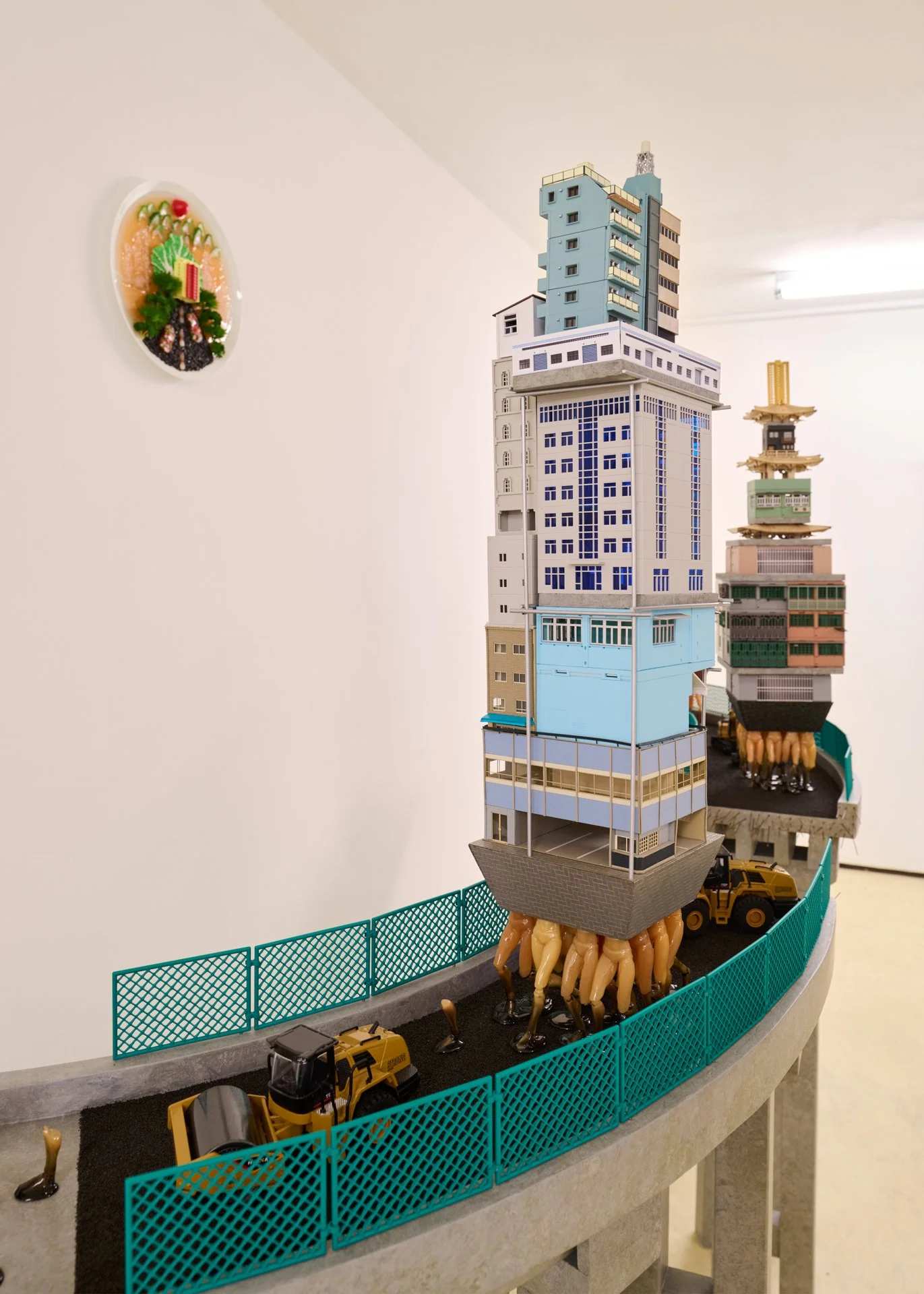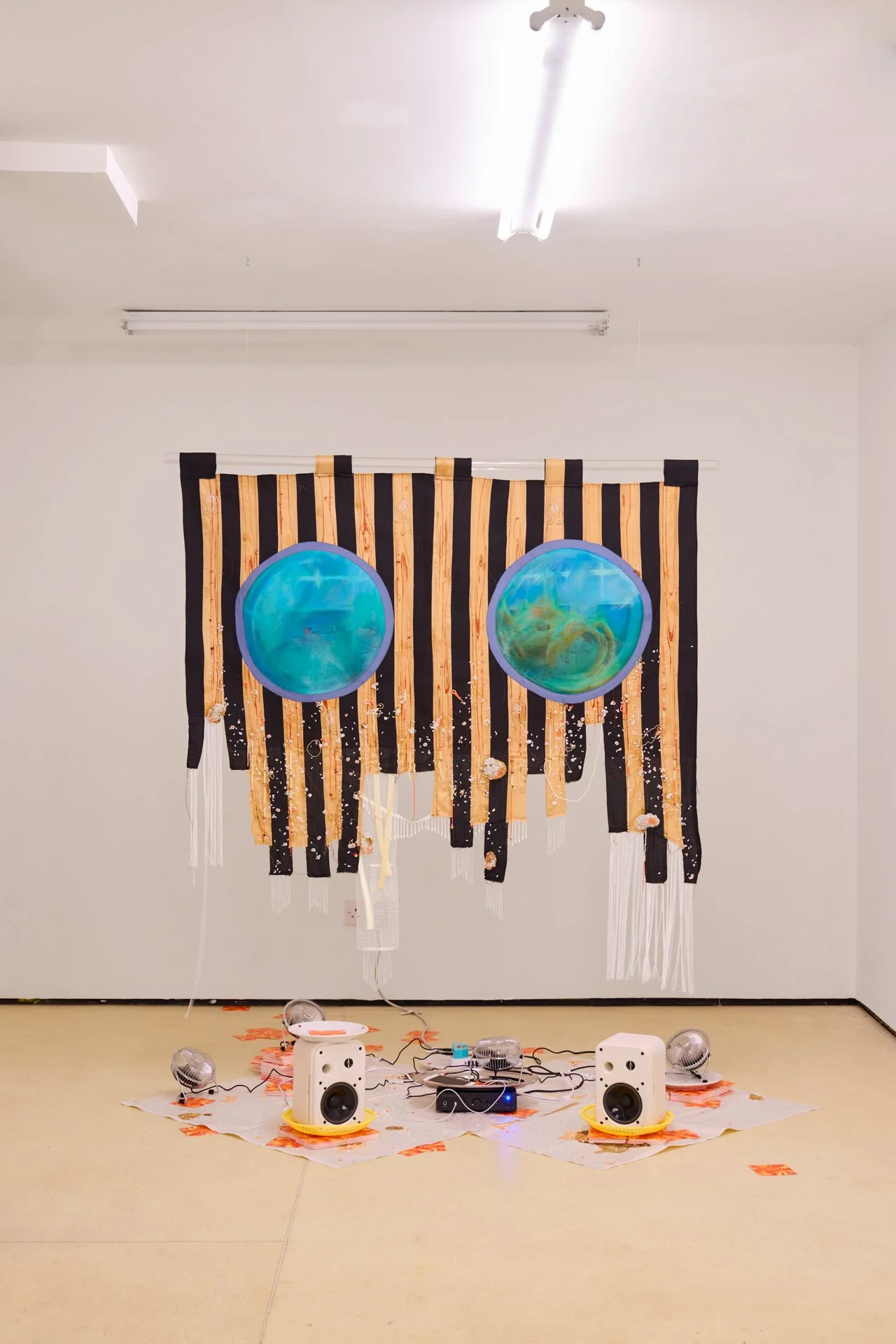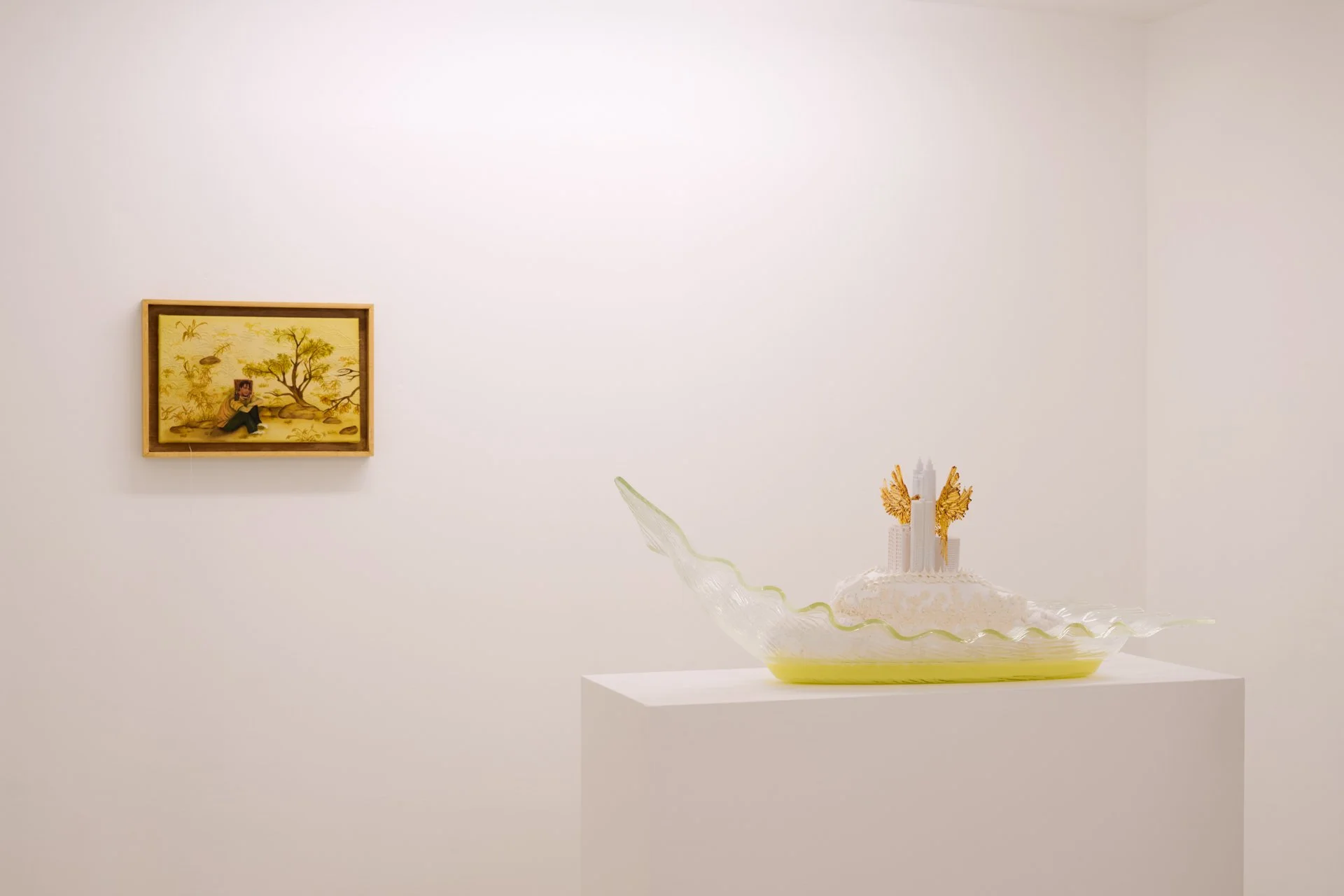DECADENTLY ORDINARY
LEILY MOGHTADER MOJDEHI & MEITAO QU
14/06/25 - 03/08/25
I remember a fruit bowl in my grandparents’ old house, the centrepiece on a low table in the centre of the living room. Smooth to the touch but opaque, only the objects stacked highest were visible. While taking the physical form of fruit, they were ceramic, full of embellishments and adornments. I remember the ‘apple’ vividly, the way it felt almost coarse, bejewelled. I was overwhelmed with the curiosity of how similar to fruit it might have been, although I never dared to bite it. That fruit bowl, filled with not-fruit, resting in the middle of their table became a testament to the meaning imbued within these objects.
Making art is often a narrative in and of itself, irrespective of what the final piece ends up looking like; the process of creation telling a story – of the artist, their materials, their obsessions – that turns into something akin to a full stop when the work itself is complete. As much as the work can be complete; always opening itself up anew when someone encounters it; space, time, the labour of making, all of these collapse in on each other, turning into the moment where someone encounters a piece of work. If art is narrative, then maximalist aesthetics take that act of storytelling and kick it into overdrive; a desire to let art overflow with meaning, material, interpretation. This has been described to me in the same terms as the feeling of coming back home after a long time away: a desire to experience everything at once as a response to overwhelming feelings of nostalgia.
This abundance of feeling comes through the vast landscapes of Leily Mojdehi’s tapestries; the overlapping of locations and timelines, an elemental connective tissue between places and objects. In Air-conditioned underground malls are a mecca (2025) tendrils of water form the bottom of a fountain, with elevators and tower complexes looming above it. Amidst the flow of water, sushi rolls and slices of nigiri emerge. These fragments feel incongruous at first, but seem to transform into the mental landscape of memory. The artist’s collages, placing pieces of popular culture onto pastoral backgrounds, act as a way of sometimes literally stitching together layers of past and present. In Cool breeze over the mountains (2024), set against rocks and trees, a figure sits, with their arms crossed. Superimposed over their own face is a cutout of a 1989 Keanu Reeves’ face, a mirror of a Mughal painting (circa 1610 - 20) being referenced by the artist. Reeves’ face – somewhere between detached cool and downcast melancholy – becomes a narrative intervention against the landscape.
This act of storytelling evolves throughout the show, and so too does the material with which these stories are told: fast food mega-corporations, the faces of actors, fragments of sushi, all are equally viable material with which to capture overwhelming, often contradictory feelings. It’s through this maximalism, through the visible ways in which one image or feeling is layered on top of another, that this visual abundance, bringing things together across space and time, is imbued with its own unique power.
This is rendered corporeal in Meitao Qu’s two-part installation Round and Round We Go (2024). In one room, a building block castle that looks as if it’s been pulled straight from Disneyland slowly rotates on a silver butler’s tray, revealing the utilitarian architectures behind its pastel facade. In contrast to the miniature villas beneath which elongate into narrow apartment blocks, surrounding it like cardinal points, the castle itself is elevated on a dessert tray, and covered by a cloche dome. There’s something distant, utopian, about the castle, as if it exists through the haze of memory. In another room, Qu extends this creation of miniature worlds with parade floats of brutalist skyscrapers and construction machinery; there’s a decadence to these sculptures, even as they’re rendered inseparable from the labour of their creation - the model legs of workers whose upper bodies have been subsumed by the structures, the space between labour and its product collapsing together.
Both artists create work defined by the elaborate layering and overlapping of materials, meanings, and sometimes even artistic forms. The impulse here is one not just of creating a narrative, but understanding just how ephemeral the way we tell stories – and remember them – can be. The castle at the centre of every Disneyland Park tells a story, but to see it upheld by utilitarian constructions in Qu’s work forces us to reconsider how we understand the castle, in the same way that Mojdehi uses the face of an actor to intervene on how we might otherwise understand a work. Through this continual outward development of images and ideas, ironically, carries with it an impulse to excavate: to constantly go deeper down and create new understandings of how these ideas intersect with each other.
Both Mojdehi and Qu build elaborate environments that serve as a reminder of just how much our own worlds are constructed, and how our memories – of places, of food, of the pop culture phenomena that might have defined our childhood – are inescapable, always recurring and imposing themselves on top of the world as we see it, daring us to feel everything all at once.
Text by Sam Moore
Leily Moghtader Mojdehi is an Iranian, Singaporean-British artist based in London. She holds a BA (Hons) in Fine Art from Goldsmiths University of London (2021). Since graduating, she has exhibited at galleries and museums internationally, in both London and Malaysia, and was one of the artists selected for the 2022 Bloomberg New Contemporaries. She has also been awarded the City of London x Outset Studiomakers Prize (2022), Incubating Residency at Pictorum Gallery (2022), as well as Residents (2021) - a yearlong residency at the Goldsmiths CCA as a founding member of the Floor Five Collective.
Mojdehi’s practice intertwines mediums such as painting, textiles and sculpture. Weaving inspiration from millennia of ancient traditions, an all-knowing algorithm and personal narratives, Mojdehi creates mixed-media works that act like a woven diary. This playful mixing creates a gentle confusion between the real and the representational in: densely layered collage compositions, to tell embellished stories of unplaceable experiences.
___
Meitao Qu is a UK-based Chinese artist working across sculpture, installation and digital media. She holds an MFA from the Ruskin School of Art (2021), funded by the Oxford-Kaifeng Graduate Scholarship, and a BA in Fine Art and Art History, Goldsmiths College (2019). Taking global spectacles such as World’s Fairs and consumer capitals like Disneyland as sites of inquiry, her practice explores how objects and the built environment carry a visual economy that mobilises ideological narratives for popular consumption, reproduced under the guise of entertainment and play. Traversing historical and speculative imaginaries, Meitao’s work explores how architecture operates as a mode of worldbuilding that transforms the abstract into the tangible and fantasies into reality.
Recent solo exhibitions include Public Gallery, London (2024); Harlesden High Street, London (2023) and Naebono Art Studio, Sapporo (2022). She was an Artist-in-Residence at the Fukuoka Asian Art Museum, Japan (2024) and is currently undertaking a research fellowship at the Institute of Creative Technologies, Norwich University of the Arts.









































